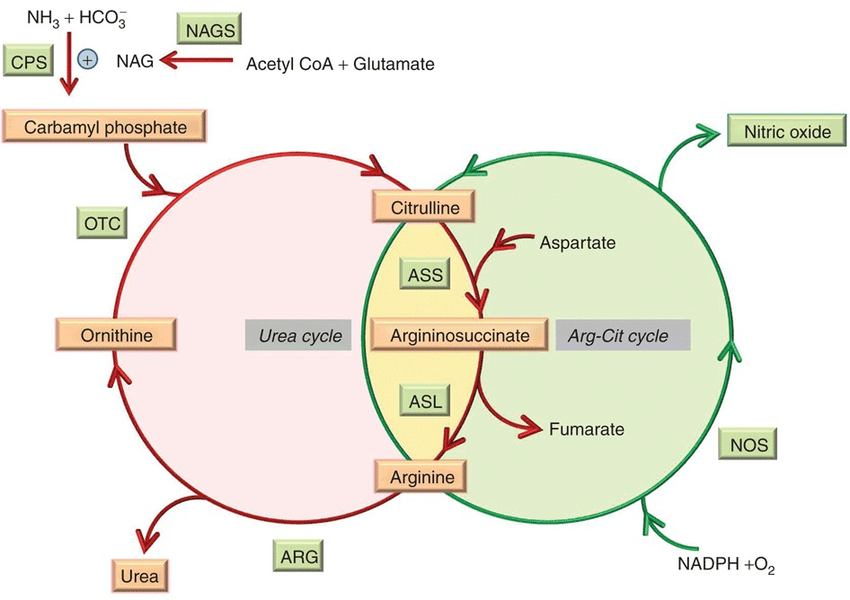Citrulline is a precursor to arginine.
Citrulline is a precursor of arginine in the Urea Cycle and Arg-Cit Cycle. Dietary proteins cannot be a direct source of L-Citrulline to the body because L-Citrulline is not a component of proteins, like most other amino acids are.
In the first cycle (left side of FIGURE 1), citrulline is converted to arginosuccinate and then to arginine. From that point the enzyme arginase cleaves off urea for disposal via urine, leaving ornithine. Ornithine is converted to citrulline, and the cycle repeats. In the second cycle (right side of FIGURE 1), arginine, acted upon by the enzyme nitric oxide synthase (NOS), is converted directly to citrulline and the cycle repeats.
In this model, supplemental citrulline will be converted to arginine and via the Arg-Cit Cycle, increase nitric oxide, which in turn will lower blood pressure and improve the function of endothelial tissue in arteries. Citrulline may be more effective than supplemental arginine in this function because increasing arginine induces the enzyme arginase.
FIGURE 1: Urea Cycle and Arg-Cit Cycle
ABBREVIATIONS: ARG = Arginase; NOS = Nitric Oxide Synthase; ASS = Arginosuccinate Synthase; ASL = Arginosuccinate Lysase; OTC = Ornithine Transcarbamylase
SO WHY NOT ARGININE?
L- Citrulline increase blood plasma Arginine better than Arginine does.
A meta-analysis of eleven placebo-controlled clinical trials involved 387 patients, with oral
L-arginine intervention ranging from 4 to 24 g/day. Compared to placebo, systolic blood pressure decreased by 5.4 mmHg and diastolic blood pressure by 2.7 mmHg, both statistically significant (P<0.001).1 A review stated that supplemental arginine, in addition to lowering blood pressure, increased plasma L-arginine, increased nitric oxide (NO) production, and improved the status of other cardiovascular disease associated with endothelial dysfunction. The problem is that these benefits are not sustained over time. Arginase is induced, meaning that urea production increases, and plasma arginine reverts to pre-treatment concentration despite the continued supplementation. Increasing L-arginine to above 10 g/day in attempts to overcome the diminished response leads to reduced absorption and risk of diarrhea.2
When arginine is consumed, much of it is quickly metabolized away by the enzyme arginase.
Citrulline does not trigger arginase so it avoids this problem.
When L-citrulline is used as a dietary supplement it is converted into arginine in the kidneys. The post-dose increase in plasma L-arginine, is slower and last longer compared to supplementing with L-arginine. Of greater importance, L-citrulline does not induce arginase. Schwedhelm’s clinical trial demonstrated first, that L-citrulline was absorbed and appeared in plasma in a dose-responsive manner, and second, that for equal amounts of L-arginine and L-citrulline, the latter resulted in 50% higher blood concentration of L-arginine.3 For these reason, it has promise as a therapeutic adjunct in disease states associated with low nitric oxide.2,3
L-CITRULLINE EVIDENCE FOR BLOOD PRESSURE
L-Citrulline supports healthy blood pressure and heart function
In healthy young men, two weeks or four weeks of L-citrulline at 6 g/day did not affect blood pressure or artery stiffness at rest, but did reduce exercise-caused and cold-exposure-caused increases in blood pressure and arterial stiffness.4,5 Heart failure patients were randomized to placebo or 3 g/day L-citrulline for four months. Both left and right ventricular ejection fraction increased with treatment, and was statistically significant compared to placebo control. One-third of the treated group reported that they were able to be more physically active without pain or discomfort.6
Watermelon is a known source of L-citrulline, and a L-citrulline rich watermelon extract has been tested in clinical trials. Six weeks of 6 g/day reduced systolic BP from 138 to 126 mm Hg, and diastolic form 79 to 72 mm Hg.7 Is a crossover trial, same dose, same duration, subjects diagnosed with hypertension or pre-hypertension, both systolic and diastolic blood presure were decreased compared to placebo treatment.8
SAFETY
In an uncontrolled trial of two years duration, children consumed L-citrulline at 2.0 to 2.2 g/day and did not exhibit side effects.9 Shorter trials of length in weeks to months and doses 1 to 8 g/day did not report adverse events differing from what was seen for placebo.4-8
OTHER HEALTH BENEFITS
Outside the scope of this review are various other health claims made for L-citrulline. Enhanced exercise capacity is attributed to L-citrulline and to L-citrulline & malate combination products.10-19 (In this context, malate is a tricarboxycylic acid cycle intermediate providing energy for ATP production. Citrulline-malate in combination is marketed as an exercise performance supplement at 6-12 grams/day.)
Vascular dysfunction contributes to erectile dysfunction, and there is evidence from a human trial that citrulline supplementation improves sexual performance
Arginine supplementation has been suggested as a means of reducing erectile dysfunction, through the proposed mechanism of nitric oxide increasing vascular dilation. In one human trial, a month of L-citrulline at 1.5 g/day was reported to improve erection hardness in 50% of the subjects versus 8% for placebo.20



